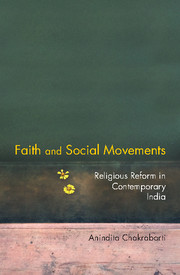Book contents
- Frontmatter
- Contents
- List of Figures
- Preface
- Acknowledgments
- Introduction: Dissent, Religion and Civil Society
- Part I Svadhyaya Ethics and the Spirit of Voluntarism
- Part II The Tablighi Jamaat's Call for Self-reform
- 5 Pedagogy of Tablighi Reform: The Mission and the Messenger
- 6 ‘Unintended Consequences’ of Piety and Discourses of Islamic Reform
- Conclusion: Religion, Movements and Secularity
- Glossary
- Bibliography
- Index
6 - ‘Unintended Consequences’ of Piety and Discourses of Islamic Reform
from Part II - The Tablighi Jamaat's Call for Self-reform
Published online by Cambridge University Press: 28 February 2018
- Frontmatter
- Contents
- List of Figures
- Preface
- Acknowledgments
- Introduction: Dissent, Religion and Civil Society
- Part I Svadhyaya Ethics and the Spirit of Voluntarism
- Part II The Tablighi Jamaat's Call for Self-reform
- 5 Pedagogy of Tablighi Reform: The Mission and the Messenger
- 6 ‘Unintended Consequences’ of Piety and Discourses of Islamic Reform
- Conclusion: Religion, Movements and Secularity
- Glossary
- Bibliography
- Index
Summary
Last evening, at Kathod, a twelve or thirteen year old boy ran after a bus and latched on to the ladder fixed to the back of the bus. He was wearing a white kurtā pājāmā and a skull-cap. My companion said (in jest), ‘Look at the future Osama-bin-Laden.’
Fieldnotes, December 2001, HarshpurIf a drop of alcohol falls on a cloth, a Muslim is supposed to burn it. But you can see what is the situation today, even Muslims are involved in bootlegging.
Tablighi Jamaat volunteer, Ratanpur, Surat district, November 2001In the last chapter, I discussed the Tablighi Jamaat's call for ethical reform to their co-religionists and how the movement seeks to turn away from worldly concerns. Yet, their quietism has had different consequences in varying sociopolitical contexts. It has been seen as serving political ends where Islam is the majority religion (Pakistan), a safe refuge for Islamists when Islamism is attacked (Bangladesh after 1971) or as a pragmatic strategy where they are a minority (India and Britain).1 For secularists, such movements pose the problem of asserting religious identity in the ‘secular’ public sphere. The veil, the skull-cap and flowing beard emerge as unacceptable trespass in the domain of the secular. The headscarf issue in France showcases this uneasy tension between the secular nation-state and ‘conspicuous religious symbols.’ The academic writings on the Tablighi Jamaat have very often echoed similar unease. The discourse, in the Indian context, has been framed within the binary of syncretism versus fundamentalism, and portrayed the Tablighi Jamaat as a reformist movement opposed to syncretic ethos and Sufi practices. Tracing the origin of the movement in the identity politics of the late nineteenth and early twentieth centuries, these studies have prioritized the ‘political’ outcome of religious reform.
In the ‘South Asian’ context, much of the scholarly work on religious reform movements hinges on this framework of identity politics and the history of the colonial and post-colonial nation-state. Competitive contestation between communities has been the cardinal focus of the relation between religion, the public sphere and the development of reform movements.
- Type
- Chapter
- Information
- Faith and Social MovementsReligious Reform in Contemporary India, pp. 156 - 177Publisher: Cambridge University PressPrint publication year: 2017



